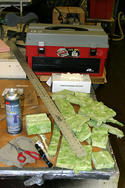Given the news spin cycle, is it any wonder that the presidency has been reduced to a talk show, or that March Madness has better ratings than the wars in the Middle East? But American presidents might think about adopting a SportsCenter model — snappy replays, contrite Tigers — and drop Rush Limbaugh and James Carville as their founding fathers. The continental divide in American history isn’t that between Democrats and Republicans, or conservatives and liberals, but whether or not the president should be a good sport. read more »
Newgeography.com - Economic, demographic, and political commentary about places
March Madness: Good Sports In The White House?
- Login to post comments
The Asian Urban Ascendancy
Urbanization doubtlessly has been the most significant demographic trend in the world for at least a century and promises to become even more significant in the future. The trend began in the United States and Western Europe as people moved by the millions from the countryside to the urban areas, where employment and a better life were possible. read more »
Immigrants Key to Economy's Revival
In Washington on Sunday, the tens of thousands of demonstrators demanding immigration reform looked like the opening round of the last thing the country needs now: another big debate on a divisive issue.
Yet Congress seems ready to take on immigration, which has been dividing Americans since the republic was founded.
But identifying immigrants as a “them,” as both their advocates and nativists do, misses the point. Immigrants — and their children — are the people who will help define the future “us.” They are also critical to the revival of the U.S. economy. read more »
A Big Company Recovery?
After the release of the 2009 fourth-quarter GDP estimate, some forecasters are now predicting a rapid recovery in 2010. Certainly, the fourth-quarter growth rate was impressive, particularly following the modest pickup reflected in the third-quarter results and the terrible results of the previous several quarters. Implicitly, these optimistic forecasts are based on the assumption that the United States economy has been fundamentally unchanged by the recession. read more »
The Not-So-Lucky Country
President Obama's last-minute decision to postpone his homecoming to Indonesia and a trip to Australia expands the list of friendly countries--which include France, the U.K. and most of Eastern Europe--that have received a presidential snub. Yet in putting off his Australia trip, Obama will also miss an opportunity to commune with the politician whom he most closely resembles. read more »
Green Jobs Sink Down Under
Remember when President Obama declared that insulation was sexy? In the wake of the global economic downturn, a “green jobs” formulation has been launched, not just here, but in every major world capital. While the White House’s financial and rhetorical commitments to the creation of green jobs are significant, no administration has made these policies as central to their government as that of Prime Minister Kevin Rudd in Australia. The results there should provide a cautionary tale for President Obama, whose trip “Down Under” is currently scheduled for June. read more »
Ruining our Cities to Save Them
Latching onto Kevin Rudd’s call for “a big Australia” and forecasts that our population will grow by 60 per cent to 35 million in 2050, urban planners are ramping up their war against suburbia. In paper after paper, academics across the country have been pushing the same line. Climate change, peak oil and the financial crisis mean we can’t go on driving and borrowing for low-density housing. read more »
Another Caution on California: Golden State’s Grassroots Are Dying
The subject line on the recent e-mail got my attention: “The Speaker wants to talk with you.”
The message referred to California State Assembly Speaker John Perez, a Democrat who represents the 46th District, which includes Downtown and nearby districts that are part of the Garment & Citizen’s circulation area.
Perez has been in the Assembly for more than two years, and he’s gotten plenty of publicity for being the first openly gay person to become Speaker. Some folks are vaguely aware that he’s a cousin to Los Angeles Mayor Antonio Villaraigosa, and a former city commissioner. read more »
- Login to post comments
Will a Dying City Finally Turn to Immigrants?
Cuyahoga County Treasurer Jim Rokakis, who is based in Cleveland, estimates that new census numbers might show Cleveland's population to be 325,000, a whopping 153,000 drop in 10 years! That would be an average of 15,000 people leaving Cleveland every year.
That’s 1,250 people jumping ship every month,
312 people fleeing the wreckage every week,
45 people evacuating every day, or
2 people running out of Cleveland every hour, 24/7, the whole year, for 10 straight years. read more »
- Login to post comments
Midwest Success Stories
Most observers do not associate the Midwest with urban success, but quite the opposite in fact. But while there are plenty of places that are legitimately suffering, there are also plenty of success stories out there that don't always get the mindshare or press they deserve. read more »






















